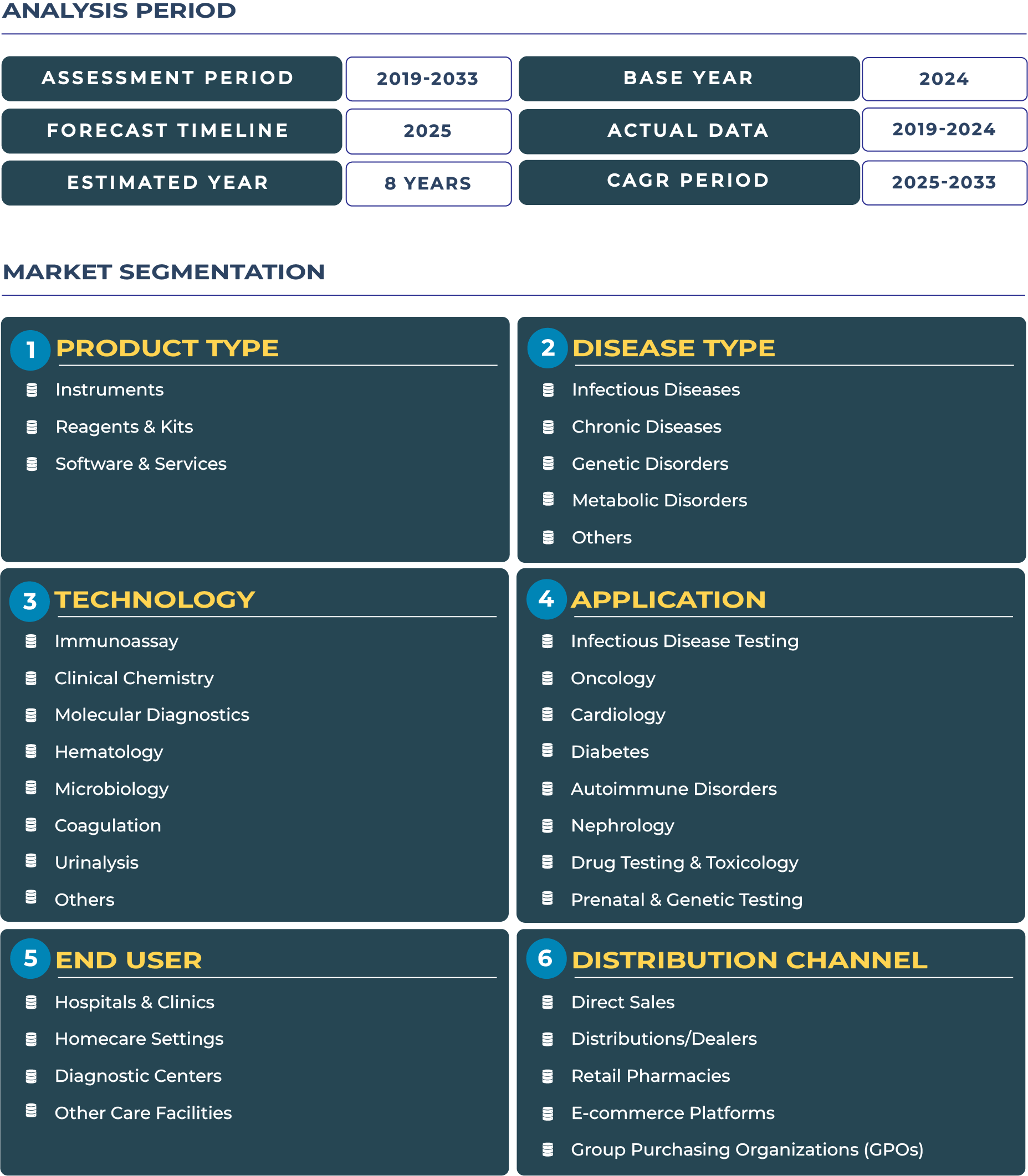EU-Backed Healthcare Modernization Accelerates Poland In-Vitro Diagnostic Market Expansion
Poland’s healthcare transformation, strongly influenced by the European Union funding initiatives, is redefining its in-vitro diagnostic (IVD) landscape. The country’s ambitious medical infrastructure modernization, supported by programs like the European Structural and Investment Funds, has elevated access to diagnostics, precision testing, and digital healthcare capabilities across public and private hospitals. This state-backed healthcare upgrade has not only improved clinical workflows but also accelerated the adoption of advanced diagnostic instruments, reagents, and analytical software in hospitals and laboratories nationwide.
The Poland In-vitro Diagnostic Market is estimated to reach USD 609.5 million in 2025 and is projected to grow to USD 1,246.3 million by 2033, registering a robust CAGR of 9.4% during the forecast period (2025, 2033). This strong performance reflects the combined effect of EU grants, increasing private healthcare participation, and growing patient awareness of early disease detection. With Poland’s Ministry of Health implementing a wide range of screening and diagnostic initiatives under its National Health Program, the IVD sector has gained strategic importance in supporting evidence-based treatment and personalized medicine adoption.
Market Outlook: EU Funds and Healthcare Digitization Bolstering Diagnostic Transformation
Poland’s diagnostic landscape is experiencing a paradigm shift driven by targeted healthcare investments, digitalization initiatives, and rising disease burden. The EU’s health infrastructure programs have enabled regional hospitals to procure advanced analyzers and molecular diagnostic platforms, boosting the integration of laboratory automation systems and reducing testing turnaround time. Furthermore, the ongoing public health emphasis on chronic disease screening, including oncology and infectious disease diagnostics, continues to fuel demand for specialized reagents and assay kits.
Domestic laboratories are increasingly adopting automated systems for high-volume testing, supported by real-time data management software. Meanwhile, private medical chains in major cities like Warsaw, Kraków, and Gdańsk are expanding their diagnostic centers, further enhancing accessibility. Collectively, these efforts demonstrate a shift toward quality-oriented healthcare delivery, positioning Poland as one of the fastest-evolving diagnostic ecosystems within Central and Eastern Europe.
Drivers & Restraints: Government Investment and Private Sector Momentum Versus Structural Challenges
Public Funding and Private Sector Expansion Fuel Market Momentum
The surge in Poland in-vitro diagnostic market is underpinned by EU-backed healthcare modernization and rapid private sector involvement. Access to EU capital expenditure grants has enabled hospitals to upgrade laboratory infrastructure, integrate automated analyzers, and establish quality assurance frameworks aligned with EU diagnostic standards. Additionally, Poland’s growing network of private diagnostic chains, such as Diagnostyka S.A., has enhanced nationwide coverage of clinical testing and molecular diagnostics. This synergy between public and private stakeholders is creating sustainable market opportunities for reagent and software solution providers.
Procurement Complexity and Workforce Shortages Pose Operational Constraints
Despite positive growth dynamics, the Polish IVD industry faces certain systemic hurdles. Procurement processes remain fragmented across voivodeships, resulting in inconsistent access to diagnostic technologies. Additionally, regional disparities in healthcare staffing, particularly in smaller provinces, limit the operational efficiency of newly installed diagnostic systems. Pricing pressures, arising from both public tenders and private competition, also restrict profit margins for international manufacturers, compelling them to localize production or distribution. These challenges highlight the need for unified procurement standards and targeted skill development programs to sustain growth momentum.
Trends & Opportunities: Localization, Public-Private Partnerships, and Digital Integration Defining Market Future
EU-Funded Hospital Upgrades and Private Chain Expansion Reshaping the Diagnostic Landscape
Ongoing modernization of regional hospitals through EU-backed projects is facilitating the adoption of next-generation molecular diagnostic instruments and fully automated analyzers. The rise of ambulatory testing centers and outpatient diagnostic services is further driving test volumes. In parallel, private healthcare operators are consolidating diagnostic networks across cities, focusing on specialized assays in oncology, microbiology, and immunology. Poland’s healthcare system is witnessing growing digital integration, where diagnostic software platforms play a key role in linking test results with clinical decision support tools.
Localization and Partnership Models Creating Competitive Differentiation
As healthcare procurement aligns with EU funding cycles, local manufacturing and distributor partnerships are becoming essential market entry strategies. Companies leveraging EU grant-linked positioning are achieving faster procurement approvals and improved margins. Opportunities also lie in offering localized reagent formulations and value-for-money testing kits tailored to public hospital needs. Furthermore, the demand for tele-training solutions is growing rapidly, as remote laboratories and regional facilities seek digital capacity-building programs for diagnostic staff, especially in underserved provinces.
Competitive Landscape: Strategic Partnerships and Localization Shaping Market Competitiveness
Poland’s in-vitro diagnostic sector hosts a mix of international leaders and regional innovators. Key multinational participants such as Roche Diagnostics, Siemens Healthineers, and bioMérieux continue to expand their local footprint through distributor collaborations and capacity-building initiatives. These companies have increasingly focused on localized partnerships to mitigate procurement delays and currency risks while ensuring supply continuity. Meanwhile, domestic players like Diagnostyka S.A. are strengthening their testing capabilities through automation and digital integration, offering competitive turnaround times and pricing structures.
Recent market developments include joint ventures aimed at reagent co-production and software localization to comply with Poland’s health data security frameworks. Training initiatives supported by both the Ministry of Health and private diagnostic firms have further enhanced laboratory skill levels, contributing to sustainable market development and reinforcing Poland’s position as a regional diagnostic hub.







